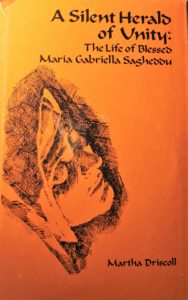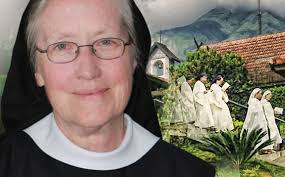Review: of A SILENT HERALD OF UNITY by Martha Driscoll (Ethiopia)
A Silent Herald of Unity: The Life of Blessed Maria Gabriella Sagheddu
by Martha Driscoll OCSO (Ethiopia 1965–67)
Kalamazoo: Cistercian Publications
1990
142 pages
$45.94 (hard cover), $4.95 (paperback)
Reviewed by Patricia Taylor Edmisten (Peru 1962–64)
•
FOR NON-BELIEVERS, Protestants or Catholics who no longer attend services or Mass, the experience of reading this book will be like entering an exotic country without benefit of cultural sensitivity training. I speak as a still-practicing Roman Catholic, despite my disagreements with Rome. Without familiarity with the concepts and language of monasticism, self-denial (lots of it), ritual, and frequent prayer, at a time when women continue to press for respect and equal treatment under the law, this book will appear anachronistic. Readers would do well, however, to reserve judgment and pay respectful attention to the no-nonsense prose of Sister Martha Driscoll. “Mother Martha,” as she is known, is Mother Superior of an Indonesian monastery for women who have taken their vows in the Order of Cistercians of the Strict Order. These are women who live their lives according to the Rule of St. Benedict (480-550 AD). The Rule is a guide for monks and women religious who embrace a life dedicated to pax, ora et labora (peace, prayer, and work).
This is not the kind of book that is usually reviewed in Peace Corps Worldwide, and had I held on to some earlier sensibilities, I would have had no qualms about writing this review. I’m taken back to a silent retreat I attended in my senior year at Jesuit Marquette University in Milwaukee, Wisconsin. The nuns, who lived at The Cenacle on a bluff overlooking deep blue Lake Michigan, were cloistered. They never left, and they lived according to a strict religious code. Toward the end of that peace-filled retreat, I spoke with the Mother Superior and told her that I was disposed to entering religious life. My last semester of college intervened, however, along with my job and social life.
Mother Martha has written a book about young Maria Gabriella Sagheddu who was born in 1914 and grew up in the bosom of a traditional Sardinian Catholic family. Disease, death, and, sorrow took its toll on Maria and her surviving family. As a child, Maria was impatient, demanding, and had serious anger issues. During her teen years she drew closer to the Church and studied her catechism and the lives of the saints. She aspired to be saint-like. Eventually, Maria joined one of the few Trappist monasteries for women in Laval, France. As a postulant, Maria lived with other Trappistines in strict observance of the Rule of Benedict. Over the years, Maria became the gentle, self-sacrificing, obedient woman who dedicated her life to serving God as she also served others. Mother Martha describes the means by which Maria Gabriella is transformed:
Monastic life, with its complete separation from the world and its minute regulation of every moment of the day, forms a way of life very different even from the tranquil atmosphere of a Sardinian town. Time is marked by the bells that call now to manual work, now to prayer. The deep vital movement of choral prayer which begins in the night, pauses for a time of silence, explodes at daybreak in Lauds and continues throughout the day, is the principal axis around which life resolves. In the peaceful flow of Gregorian chant the body relaxes, the heart reposes in deep recollection and exults in praise. The mind becomes open and receptive and the spirit is imbued with the mystery that is alive and present in a way far beyond where the mind can grasp or words repeat. Simple gestures silently accompany even the most banal activities of daily life (going off to work in the fields in single file, greeting one another with a slight bow), transforming everything into a kind of liturgy. They were not rigid formalities deprived of meaning for anyone who entered the life with love. They created an environment in which universal charity, sincere and humble fraternal love, and continual prayer could flourish and grow.
Does not the life described so invitingly above appeal to your yearning for calm in a swirling life of deadlines, dissatisfactions, and political nonsense? But Mother Martha is describing a permanent way of life, not a weekend retreat for which we might pay big bucks.
By the end of the book we learn that Sister Maria Gabriella asks permission of her superior to “offer” her life for Christian unity. “Why would anyone need to ask permission for something like that?” I asked myself. It took me a while before I realized that it wasn’t permission to dedicate herself to a cause in the ordinary sense. Instead, Sister Maria Gabriella was asking if she could literally offer herself through suffering and death for Christian unity.
It wasn’t long before piercing shoulder pain and other ailments led to the diagnosis of tuberculosis. Sister Maria Gabriella received loving and good medical care, appropriate for the times. Her sisters didn’t allow her to go into that dark night without a fight. After two pain-wracked years, on April 23, 1939, when she was only twenty-five, she joyfully embraced her death. Sr. Maria Gabriella’s wish to “offer” herself was fulfilled, although we still await the unity for which she dedicated her suffering and death.
Who are we to judge that a Creator Lord, or, to be politically correct, a “Higher Power,” did not respond to Sister Maria Gabriella’s prayers for unity among peoples of the world? For as in 2 Peter: 3-8, “With the Lord a day is like a thousand years, and a thousand years are like a day.” I’ve ended this review with a Catholic’s interpretation, but we should not dismiss this tribute to the life of Maria Gabriella Sagheddu because we’ve been around the world and know first-hand the suffering that never seems to be relieved by prayer. Let’s not become so jaded that we belittle the life of a young woman who demonstrated selflessness, generosity, faithfulness, and a comprehensive love of humankind, as ably told by Mother Martha Driscoll. My guess is that it was her experiences with the suffering of others while serving as a Peace Corps Volunteer in Ethiopia that led Martha Driscoll to her life as a Cistercian and, ultimately to this book.
Years after her death, a commission of cardinals decided that Sister Maria Gabriella’s life of unstinting devotion to “evangelical virtues” was such that they proclaimed her “Venerable,” the first step on the way to sainthood. In 1982, medical experts consulted, by the sacred Congregation for the Causes of Saints, declared that there was no medical explanation for the restoration of sight in an elderly sister for whom Sr. Maria Gabriella had prayed and sacrificed. The return of sight, therefore, was declared a miracle. That same fall a theological commission came to the same conclusion. Now Sister was declared “Blessed.” It could be that this book by Mother Martha Driscoll will advance the cause of sainthood for Sister Maria Gabriella Sagheddou.
•
Patricia Taylor Edmisten is the author of A Longing for Wisdom: One Woman’s Conscience and her Church. Her other books may be found at PatriciaEdmistenBooks.com.


I love the description of herself by the reviewer who seems to draw me back to roots, mine.
Hi, Edward. Yes, it’s hard to take the “Catholic” out of those of us who grew up with it as both faith and culture. Thanks for your comment.
Patricia
I learn so much for the wonderful reviews by RPCVs of work of RPCVs. I think that the reviews themselves should be compiled into a book.
I expected a brilliant review from Patricia, who understands these religious and spiritual issues most deeply and writes about them so eloquently. Thank you for bringing us to Mother Martha Driscoll again and to the amazing image of a Sardinian future saint.
Her story reminds me of Grazia Deledda, Sardinian author who was the first Italian and woman to win the Nobel Prize for Literature in 1926 for her work and especially her book, “Reeds in the Wind.” We are the reeds and fate is the wind.
Brava, Patricia!
Leita